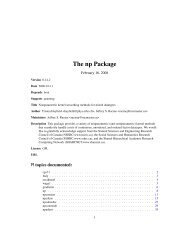The gstat Package - NexTag Supports Open Source Initiatives
The gstat Package - NexTag Supports Open Source Initiatives
The gstat Package - NexTag Supports Open Source Initiatives
You also want an ePaper? Increase the reach of your titles
YUMPU automatically turns print PDFs into web optimized ePapers that Google loves.
<strong>gstat</strong> 11DetailsValuevarianceweightsmergecharacter; variance function to transform to non-stationary covariances; "identity"does not transform, other options are "mu" (Poisson) and "mu(1-mu)" (binomial)numeric vector; if present, covariates are present, and variograms are missingweights are passed to OLS prediction routines; if variograms are given, weightsshould be 1/variance, where variance specifies location-specific measurementerror as in Delhomme, J.P. Kriging in the hydrosciences. Advances in WaterResources, 1(5):251-266, 1978; see also the section Kriging with known measurementerrors in the <strong>gstat</strong> user’s manual, URL see below.either character vector of length 2, indicating two ids that share a common mean;the more general <strong>gstat</strong> merging of any two coefficients across variables is obtainedwhen a list is passed, with each element a character vector of length 4,in the form c("id1", 1,"id2", 2). This merges the first parameter forvariable id1 to the second of variable id2.degree order of trend surface in the location, between 0 and 3... arguments that are passed to the printing of variogram models onlyto print the full contents of the object g returned, use as.list(g) or print.default(g)an object of class <strong>gstat</strong>, which inherits from list. Its components are:datamodelsetlist; each element is a list with the formula, locations, data, nvars,beta, etc., for a variablelist; each element contains a variogram model; names are those of the elementsof data; cross variograms have names of the pairs of data elements, separatedby a . (e.g.: var1.var2list; named list, corresponding to set name=value; <strong>gstat</strong> commands (look upthe set command in the <strong>gstat</strong> manual for a full list)Note<strong>The</strong> function currently copies the data objects into the <strong>gstat</strong> object, so this may become a largeobject. I would like to copy only the name of the data frame, but could not get this to work. Anyhelp is appreciated.Subsetting (see examples) is done using the id’s of the variables, or using numeric subsets. Subsetted<strong>gstat</strong> objects only contain cross variograms if (i) the original <strong>gstat</strong> object contained them and(ii) the order of the subset indexes increases, numerically, or given the order they have in the <strong>gstat</strong>object.<strong>The</strong> merge item may seem obscure. Still, for colocated cokriging, it is needed. See texts byGoovaerts, Wackernagel, Chiles and Delfiner, or look for standardised ordinary kriging in the 1992Deutsch and Journel or Isaaks and Srivastava. In these cases, two variables share a common meanparameter. Gstat generalises this case: any two variables may share any of the regression coefficients;allowing for instance analysis of covariance models, when variograms left out (see e.g. R.
















